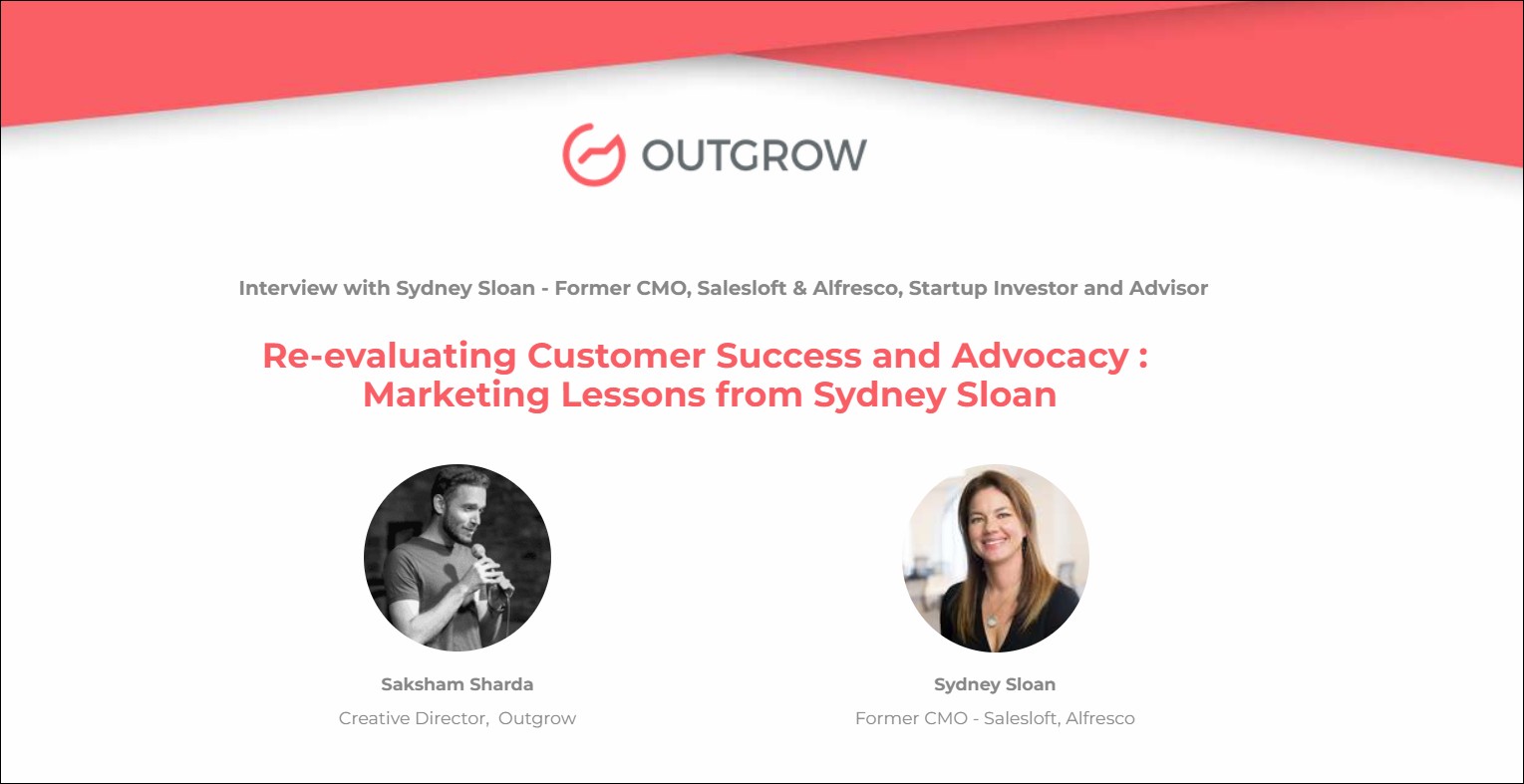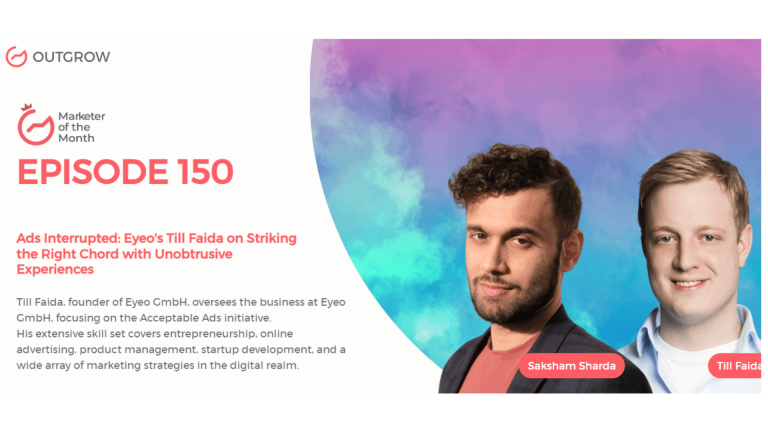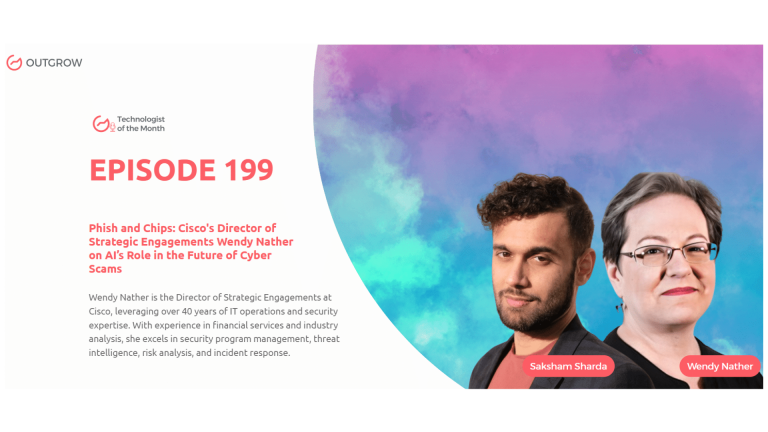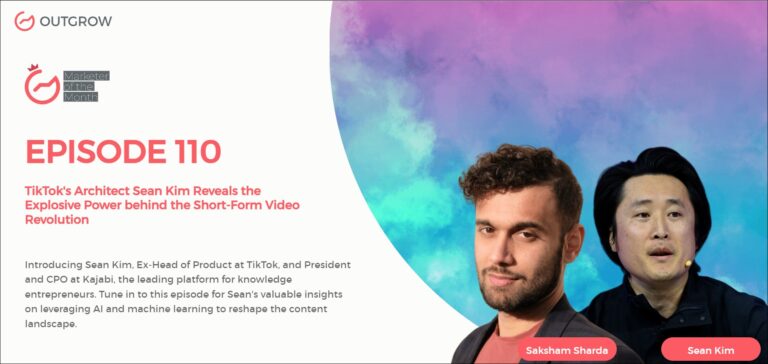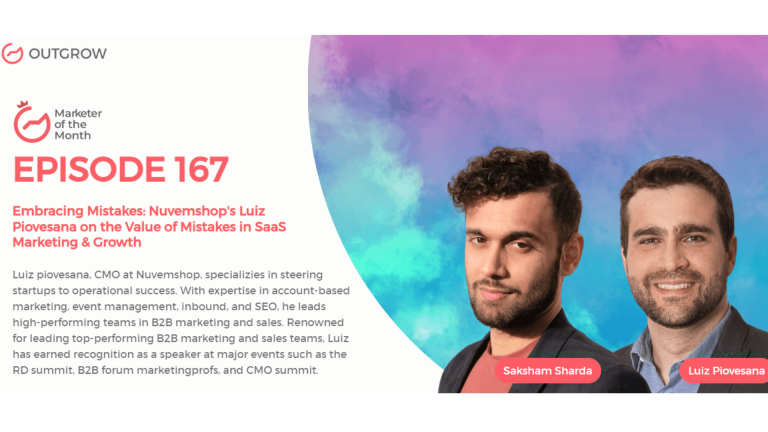Marketer of the Month Podcast With Sydney Sloan
Table of Contents
Hey there! Welcome to the Marketer Of The Month blog!
We recently interviewed Sydney Sloan for our monthly podcast – ‘Marketer of the Month’! We had some amazing insightful conversations with Sydney and here’s what we discussed about –
1. The biggest challenge that CMOs of this decade are facing
2. How spending on your brand over time reduces the cost of demand generation
3. Effectively measuring and implementing a new brand
4. Disciplines that contribute to a positive customer experience
5. Sydney’s involvement in customer experience management for Adobe’s most strategic customers
6. Becoming a function of the market: skills to hone to emerge as a top CMO
About our host:
Dr. Saksham Sharda is the Chief Information Officer at Outgrow.co. He specializes in data collection, analysis, filtering, and transfer by the means of widgets and applets. Interactive, cultural, and trending widgets designed by him have been featured on TrendHunter, Alibaba, ProductHunt, New York Marketing Association, FactoryBerlin, Digimarcon Silicon Valley, and at The European Affiliate Summit.
About our guest:
Sydney is a CMO, board advisor, and thought leader who has held senior leadership positions in product marketing, operations, field marketing, partner marketing, business development, and customer experience. Sydney served as a CMO at Alfresco and then Salesloft after managing enterprise product marketing and industry solutions marketing at Adobe Systems for 9 years.
Re-evaluating Customer Success and Advocacy: Marketing Lessons from Sydney Sloan
The Intro!
Saksham Sharda: Hi, everyone. Welcome to another episode of Outgrow’s Marketer of the Month. I’m your host, Dr. Saksham Sharda. I’m the creative director at Outgrow. co. And for this month we’re going to interview Sydney Sloan, who is the former CMO of SalesLoft. Thanks for joining us, Sydney.
Sydney Sloan: Happy to be here. Thank you for having me.
Don’t have time to read? No problem, just watch the Podcast!
Or you can just listen to it on Spotify!
The Rapid Fire Round!

Saksham Sharda: We are going to start with a rapid-fire round just to break the ice. You get three passes in case you don’t want to answer the question, you can just say pass. But try to keep your answers to one word or one sentence only. Okay?
Sydney Sloan: Okay, I’m ready.
Saksham Sharda: Okay, so the first one is at what age do you want to retire?
Sydney Sloan: 50, which is before now. I’m taking a year off. So that’s kind of getting a taste of semi-retirement.
Saksham Sharda: The next question was, how do you relax and you’re saying by taking a year off?
Sydney Sloan: Yeah, taking a year off, being by the water.
Saksham Sharda: A fruit you can eat at any time of the day.
Sydney Sloan: Apple
Saksham Sharda: What historical event do you wish you could have witnessed?
Sydney Sloan: I’m gonna pass on that one.
Saksham Sharda: A film that can be seen several times without becoming boring?
Sydney Sloan: Bohemian Rhapsody. Going to see it again for like the 15th time.
Saksham Sharda: Okay, what are you most likely to be arrested for?
Sydney Sloan: Speeding.
Saksham Sharda: Okay, a habit of yours that you hate?
Sydney Sloan: Eating late at night.
Saksham Sharda: Work from home or work from office?
Sydney Sloan: Office, I’m an extrovert in the sense.
Saksham Sharda: How many hours of sleeping can you survive on?
Sydney Sloan: Five. But I’d prefer not to.
Saksham Sharda: How many cups of coffee do you drink per day?
Sydney Sloan: I’m down to one from four, doing better.
Saksham Sharda: Favorite Netflix show?
Sydney Sloan: The Flight Attendant.
Saksham Sharda: A most valuable skill you’ve learned in life?
Sydney Sloan: Forgiveness.
Saksham Sharda: How long does it take you to get ready in the morning?
Sydney Sloan: 15 to 20 minutes.
Saksham Sharda: And the last question is the city in which the best kiss of your life happened?
Sydney Sloan: Paris
Saksham Sharda: I guess it was a tough choice.
Sydney Sloan: That’s a good one.
The Big Questions!

Saksham Sharda: Okay, so let’s go into the long questions now. As a market leader, what is the biggest problem facing leaders like yourself right now?
Sydney Sloan: It is the change. The world has changed so much and is trying to adapt to new strategies, to the new ways that people want to learn, engage, and create community. It’s hard, right? Like when you take the person-to-person aspects out of relationship building, which is part of marketing’s job, how do you still make it personal?
Saksham Sharda: And do you then believe that creative design and brand development have just fallen to the wayside as there is now a greater emphasis on supporting income generation?
Sydney Sloan: I think that’s a double-edged sword that many marketers fall on. And because if you don’t like the investment and brand as early as you can make demand gen cheaper in the long run. And so if people can draw an emotional connection to the brand, if your brand is seen as a leader, as a thought leader, as the curator of communities, people want to join that. And I think that there’s such an emphasis on, and it’s expensive to develop a brand. And, I think just looking back at most recently at SalesLoft, we were one of the two leaders in the category. And our competitor did a really good job of kind of embracing the communities, the sales communities everywhere, and we did too, but not as good as they did. And they also acquired a sales media company. So they read them and that was smart. If I had the opportunity to do that again, I totally would. And so we had to work harder at building our brand and we used our employees and we were one of the lucky ways and I think that all companies can do this. But our salespeople, our frontline people were our customers. And so being able to activate their social presence helped build the brand of SalesLoft, which was as much about building relationships, so we have a lot of great brand ambassadors. If you don’t have that, then hiring evangelists is a really good way to also do that. And when you’re empowering your employees to be the representation of your brand.
Saksham Sharda: What’s one thing you wish you had done differently now going back and looking at everything?
Sydney Sloan: Well, I would have gotten to those communities faster, probably paid more for the sponsorships that we were negotiating for. There were a couple that was just ridiculous, and they didn’t make sense. So I walked away and being budget conscious versus having the long game in mind because we lost out on a couple of those really good communities. I mean so many things, right? Like, I think that’s the interesting thing about being a marketer, there are so many facets to what we do, and you’re constantly trading off. And of course, you want to do everything the best you possibly can. But you have to also be okay, knowing that you’re doing some things well, “we built a great inbound engine, we were super efficient in the way that we did it”. And yeah it took us a little bit longer to get to the other things. But those were the choices that we made, in hindsight. So I’m never the one to regret any decision because I think I try to do a very good job of taking people’s inputs and using data to make the right decision. And one thing I am is decisive, I think that lack of decision is worse than making the wrong decision. At least you’re still moving, and you can learn and adjust. So I try not to ever regret anything.
Saksham Sharda: And speaking of which, you recently did a very large rebrand for SalesLoft last year. Why did you decide that was the right time to do a brand overhaul? And what are some tips for effectively measuring and implementing a new brand?
Sydney Sloan: Well, I wanted to do it two years earlier, to be honest, an insider secret here. And we went through an entire process. And for those out there that work for founders, sometimes the brand is a representation of them personally as well. And so looking back, our founder wasn’t ready to let the old brand go. And so we went to clean it up a little bit and modernize it a little bit. But it wasn’t the overhaul I was hoping for. And what happened was when we went to register the brand mark, it was already registered. So all of a sudden we had to because we were trying to expand into new countries. And so we had to change the brand. And it took a while because it was a year-long process that we went through. And it was radical. I mean, we changed everything, but the name, every single thing, the color palette completely changed, our tone completely changed, the look and feel. And I think the thing about the brand is, it’s not just the color palettes and all the things that I just said, but it’s the way that we wanted people to feel. And that didn’t change either. So the authenticity of the name and the brand itself, in terms of our mission didn’t change, but we got to amp it up. And I’ve said this publicly, so I don’t think Kyle would be upset. I think he went to the $99 logo store and had a coupon for $70. So you know, it is their first brand, so he got his value out of the $70. The second part of your question, well the reason it was now is that we had grown up, we still look like a startup, and we were serving enterprise companies. And that was because our brand didn’t look at the quality level of the service that we were delivering. So we had to update the brand, we had to grow up. And I think the biggest part of it, and I’ve interviewed a lot of CMO’s that had gone through brand updates before, was the activation. I think so many times that people work so hard at just the mechanics of updating all the pieces and our activation programs started rolling out internally, because like I said, your people are your biggest brand ambassadors. So we started teasing internally in January and we didn’t launch the brand until September. And we activated our employees, we activated our advocates, top advocates in the community and our key influencers, customer advisory boards that we had a rolling, kind of internal thunder, and then we had this great kind of FOMO campaign that went out and so the day our engagement was better than expected. And then we kept it going those next two quarters. So continue to be everywhere and be bold. And so don’t underinvest in the activation of the brand once you go ahead and launch it. It’s not just a launch day, it’s a complete shift and change.
Saksham Sharda: And in your experience which fundamental disciplines have helped build and deliver value in the many organizations you’ve worked with, whether it be with brands or something else? How do you optimize these disciplines to support a seamless customer experience?
Sydney Sloan: That’s a good question. I think there are a lot of different ways that brands can deliver value. I think first and foremost, it’s making sure you fulfill the brand promise. And I was reading posts the other day about sellers who oversell. And when they oversell, the next step is that at renewal they have to reduce the offer and they’re more likely to churn versus sellers that almost undersell to prove the value, the customer comes and renews at a greater value and they then become more loyal. Thomason did a post on it and it was awesome. And I completely believe in that. There’s one discipline that I’ve always been a fan of, I think was about 2005, when I first started working in it and that’s the value selling, Value Engineering, Business Value assessments, whatever that might be called. And especially in enterprise sales situations, where you help the customer build out their business case, it’s their business case, it’s not yours, this is not an ROI calculator. It’s very far from that. A lot of people think that’s what it is, it’s not. You go in and you discuss the value and what are those value drivers, and you build your economic pitch around those value drivers, and then you continue in the Customer Relationship demonstrating how you delivered to those drivers. And that’s a sophisticated way to establish credibility not only for your company, but for the buyer that decided to buy your software, and you’re helping them build their reputation and showcase their good decision-making within their own company.
Saksham Sharda: And how do you think this is different because you said at some point you guys started solving a lot of enterprise customers? So how is this different from like enterprise customers versus someone less than an enterprise?
Sydney Sloan: In delivering value? It continues to go back to relationships first and foremost. The value in the very small market is, that if you do a good job of serving them when they’re small, they may go somewhere big, and so they take you with them. So we always chose to serve all customers and try to serve them to the best of our ability. And so I think it goes deeply into relationships. And how do you do that in a one-to-one and a one to few and a one-to-many? And that’s when you start to get into the one to and one-to-many, that’s where marketing can help the customer success organization, how do you build engaging programs? How do you build brand affinity? Their expertise is in serving on a call center or doing renewals and so having dedicated marketers to work with those teams on building our communities, and building programs that can help keep those customers educated and engaged is something that a role that marketing can play. And showcasing the customers and their success. And I don’t just mean case studies, right, that’s in social media, that’s in different events, that’s in helping them get awards. And so that’s an area that marketing can play a role versus an enterprise. In an enterprise, there are a lot more resources certainly inside the company that can go to investing in those accounts. But those are maybe more high-end in-person programs, where you’re spoiling the customer a little bit, or the customer advisory boards or how you treat certain customers that may be your annual events that you plan. So I think of both sides of it a little bit differently, how to serve small customers, because you have to make the math work, and you can’t do it in a one-to-one relationship. So you have to get creative and how do you do that at scale versus in larger accounts, where you have more resources to put towards that?
Saksham Sharda: So how would you say the entire buying process for customers has evolved since the time you established Adobe’s first enterprise customer marketing team and helped evangelize the importance of customer experience management for Adobe’s most strategic customers?
Sydney Sloan: Adobe. So this is back to you know, I was there for a long time but the customer experience management work and customer marketing work was like 2009-2010 and what’s interesting to me as I’ve moved from company to company is that many of the challenges, regardless of the size of the company, are very similar. And you’re just working at a different scale, maybe global versus not as global. And so the buying process itself has changed and everybody, I don’t think I’m saying anything insightful here, it is just that there are more buyers involved in the process itself. And so Gartner and Forrester have tracked this over the years is just the buying committee. Now you’re selling to a committee of buyers, not a single buyer for enterprise products, like that’s different if you’re buying Creative Suite or something like that. So you have to think about the triangulation of roles, and I think this has an impact. So I will give you two kinds of insights or a Ha’s though, as a marketer. The first is the companies who’ve recognized this have moved away from MQLs. So if I’m talking to and advising a company, and they talk about MQL and leads, I know that they haven’t made that shift yet to account-based strategies, because what they should be talking about is engaged accounts, and how many contacts in that account are engaged and how engaged are they. And so that’s the first thing is that marketing has to change our models and how we qualify, our impact, and how and when we activate our sales teams to engage in those accounts that are ready to enter the purchase, or the buying cycle itself. And so that’s one thing, that’s like an engaging account, you have to change your scoring models, you have to give different levels of credit to different personas and what kind of things they’re doing. So it’s a complete flip of the old MQL models. And you never work leads, you work accounts which means you have to also clean Salesforce, which is hard. The second thing and this is one that I find that people don’t focus on enough and so this is the nugget. So listen up, we know that it’s seven times easier to sell an existing account than it is to acquire a new one. Yet when we look at the resources that go into serving your existing customers versus acquiring new customers, they are balanced. And those first that the buying process itself, from a closed one to going live is the most important part of the entire buying process for now. Like that is when you want to make sure that you’re getting all your resources in that the handoffs are smoother, there are no handoffs ideally, you get your post sales, people involved in the pre-sales process, so it’s a smooth transition, and you celebrate their success. The other thing that you need to do is you need to re-establish your primary contacts and account because so many times the people that are buying and in the buying process are not your users or your advocate. So you have a whole new community, a whole new set of customers inside that account that you need to develop relationships with. And all too often people don’t capture those contacts, we don’t categorize them into the right roles. We don’t communicate to them in the most efficient ways because you communicate to a champion much differently than you would communicate to a system administrator. And so many times it just ends up in one big bucket. And so I think the more sophisticated companies that are driving that long-term engagement, cross-sell upsell have high renewal and low churn, which is such a critical aspect of the SaaS model, are doing or being more thoughtful about the entire buying experience.
Saksham Sharda: So what advice would you have for those seeking to pursue the CMO role in the future in addition to what you’ve said now? What do you think makes someone qualified and ultimately successful as a CMO?
Sydney Sloan: I think the CMO first has to be a leader on the executive team. Throw away all you know about marketing, and think about your leadership skills. What do you know about business? How can you contribute to the strategy of the company? What role do you play in setting the go-to-market? You need to come in with an equal seat of the sales leader, product leader, and marketing that is the go-to-market team. And so if you haven’t spent enough time with those others, your peers, or understanding their roles and their needs, then you need to start investing in that to make yourself qualified to come into the leadership role. Because you’re an executive first. You just happen to lead the function of marketing. So the second part I would say is know how to hire well, hire talented people that form your leadership team. So what you can do is lead the entire team, foster relationships across the company, and empower them to lead the different functions of marketing. And do the day-to-day tactics. And I would say that comes true, maybe in the companies hitting 50 to 75 million is probably when you want to, you know a true CMO like I’ve just described, where smaller companies you still need to get the gritty tactical, VP marketing that doesn’t mind getting their hands dirty. But still, that’s a good time to start investing and understanding the different aspects of the business. And guess what, looking at the buying cycle, championing the customer journey and the customer experience is the best way to do that. If you own the customer journey, naturally, you’re going to understand the role of sales and what they do in serving customers what customer success does in serving the customers, how the product, what is the NPS scores, what are the product reviews coming back on the product and bringing that back to the organization. So I would start there.
Saksham Sharda: What are the different functions of marketing that you’re assigned to these people you hired? Like, give us a demonstration of what you think would be the important functions?
Sydney Sloan: It’s interesting because I wish there was one model. And every time I go in, and I’m helping quite a couple of folks right now with their organizational design, it depends on the company and kind of where and what stage they’re at. For me, it’s critical always to have a strong product marketing leader, I know so many times that marketing is first looked at for demand gen. My belief is that product or that marketing is market. And so we need to understand the market, bring the point of view of the market, and that’s product marketing in my mind. The second is demand gen, of course, and building out a high-functioning predictable engine. The third is communications, a brand can fit under that, and it could stand alone as well. But your brand and comms social media like, how do you represent yourself in the market? And when you get mature going on that full spectrum of the customer experience and the customer journey, you can make sure that we speak with the same voice, if that’s before their customer and during the customer. And so, putting workshops together with other people that create content in your organization to harmonize because it’s one customer at the end of the day. So how do you have a single approach for creating content? I think it’s really important. Sometimes I’ve had Account Based Marketing or field marketing report directly to me when I want to stay close to what’s happening in the field. And so from time to time, I’ll have different roles, like I’ve had customer marketing report to me as well as analyst relations sometimes. I mean, it just depends on partners who have taken on alliances a couple of times. But I’d say the core product marketing, communications brand, dimension. And I probably put customers at that top level.
Saksham Sharda: Okay, well the last question for the interview is, what would you be doing if not marketing?
Sydney Sloan: I love what I do, I’m so lucky. Maybe two different things, maybe a professional organizer. I get great joy from creating structure from chaos and people that might go in marketing as well but like in organizing things or people. So I enjoy that. And, I think later in life helping coach people, leverage all the learnings, take the great lessons I learned from all the coaches that I’ve been able to work with over the years and pay that back when would be meaningful.
Saksham Sharda: Okay, well that was the last question.
Let’s Conclude!
Saksham Sharda: Thanks everyone, for joining us for this month’s episode of Outgrow’s Marketer of the Month. That was Sydney Sloan, who is the former CMO at SalesLoft. Thanks for joining us, Sydney.
Sydney Sloan: Thank you very much for having me.
Saksham Sharda: Check out their website for more details and we’ll see you once again next month with another marketer of the month.

